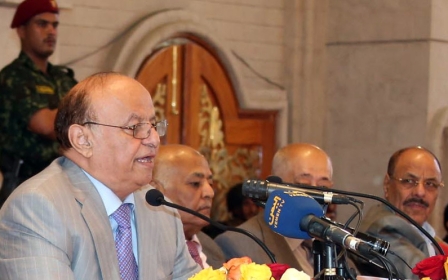The Houthis: A rising political force

The rise of Yemen's Houthis, who now enjoy considerable influence on the country's political scene, raises a number of questions about their origins and involvement in politics.
During the 1990s, the Houthis lived in the small village of Maran in the northern Saada province.
The Ansarullah movement, led by the prominent Houthi family, continued to be outlawed by the state for two decades.
But they eventually joined the revolution that erupted against autocratic president Ali Abdullah Saleh in 2011, reaping major political gains after Saleh stepped down in 2012.
These gains earned the Houthis a seat at a national dialogue conference held in March of last year – an event that gave the Shiite movement even more political clout.
The Houthis emerged as a force to be reckoned with earlier this year, when they overran several provinces of northern Yemen.
On August 14, tens of thousands of the group's followers hit the streets to demand the government's dismissal and the reversal of an earlier government decision to slash fuel subsidies.
The genesis of the Houthi movement can be traced back to 1992, when a group of Houthi youths formed what came to be known as the "Forum of Pious Youth."
The forum, however, soon fell victim to internal disagreements and infighting between members.
Initially, the Houthis functioned as an apolitical group, focusing only on religious issues and preaching. Before long, however, these religious goals turned into political ones.
This coincided with the unification of Yemen in 1990, which opened the door to the emergence of several Shiite parties – only two of which were destined to survive.
No state, no constitution
The Houthis do not recognize the state, the law or the national constitution. They consider the Yemeni revolution – which ran from 1962 to 1970 – as a coup against the nation's imams (religious leaders) and against the Islamic faith itself.
They are concentrated largely in the country's north, taking the province of Saada as their main base of operations, from which they have expanded across the entire northern region.
In Saada, Houthis have set up several training centers where they teach young people Houthi ideas.
Houthis have recently fought fierce battles around the northern Amran province, located close to Saada. On July 8, they managed to capture Amran, from which they began marching on capital Sanaa.
They are currently staging massive rallies in the capital.
The Yemeni government has more than once accused the Houthis of receiving Iranian funding. President Abd Rabbuh Mansur Hadi has also previously accused Iran of meddling in Yemen's internal affairs.
During a 2012 visit to the U.S., Hadi announced the arrest in Yemen of "cells" affiliated with the Islamic republic.
Last December, then-foreign minister Abu Bakr al-Qirbi asked Iran to stop supporting the Houthis.
The Houthis, for their part, deny the alleged links with Iran, accusing the Yemeni regime of using such accusations to deflect attention from Saudi Arabia's role in the country.
Arms, armament
According to official Yemeni military reports, the Houthis receive logistical support – including weapons – from Iran.
Some military experts say the Katyusha rockets used by the Houthis in their 2010 war with the state had also been used by Lebanese militant movement Hezbollah during the latter's 2006 conflict with Israel.
They say the presence of these rockets in the Houthis' arsenal constitutes proof that the movement receives support from Iran, Hezbollah and other Shiite groups in the region.
According to earlier international reports, Iran established a military base in Eritrea simply in order to continue supplying the Houthis with arms. Some reports stated that Iranian ships were supplying the Houthis with weapons.
Last year, Yemen's coast guard seized an Iranian ship carrying arms, which, according to reports, had been destined for Yemen's Houthis. Other official reports say the Houthis had swapped the remains of a Yemeni army commander killed in Amran for sailors from the Iranian ship.
The Houthis have refused to form a political party, saying they want their movement to remain a purely cultural movement. They hope to play a major role in the country's future by controlling a number of cabinet positions in the new unity government.
Friends, foes
From 2004 to 2010, the Houthis waged six wars against the Yemeni army, which was backed by forces from Saudi Arabia. Following the revolution that ousted Saleh, the Houthis opened new fronts against other enemies, including local tribes, Yemen's Muslim Brotherhood and the Salafists of Saada.
Since 2012, the Houthis have opposed anyone who has challenged their ideology, making enemies of the tribes of Al-Jawf that supported the army in the latter's fight against the Shiite militant group.
Some Yemenis talk of a "hidden alliance" between the ousted president and the Houthis, claiming that a number of figures associated with Saleh's party had appeared to support the Shiite movement when it attacked Amran.
Stay informed with MEE's newsletters
Sign up to get the latest alerts, insights and analysis, starting with Turkey Unpacked
Middle East Eye delivers independent and unrivalled coverage and analysis of the Middle East, North Africa and beyond. To learn more about republishing this content and the associated fees, please fill out this form. More about MEE can be found here.




